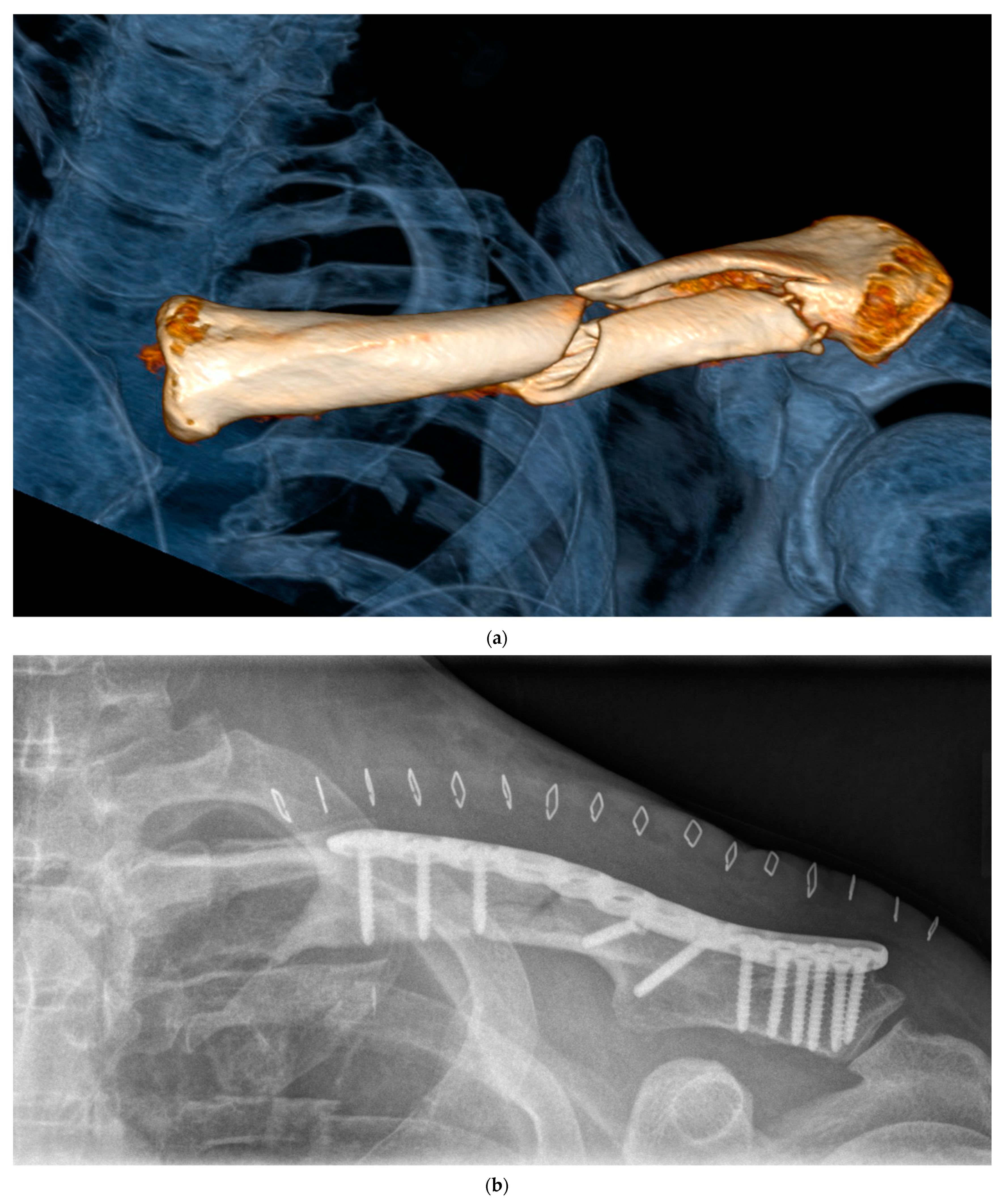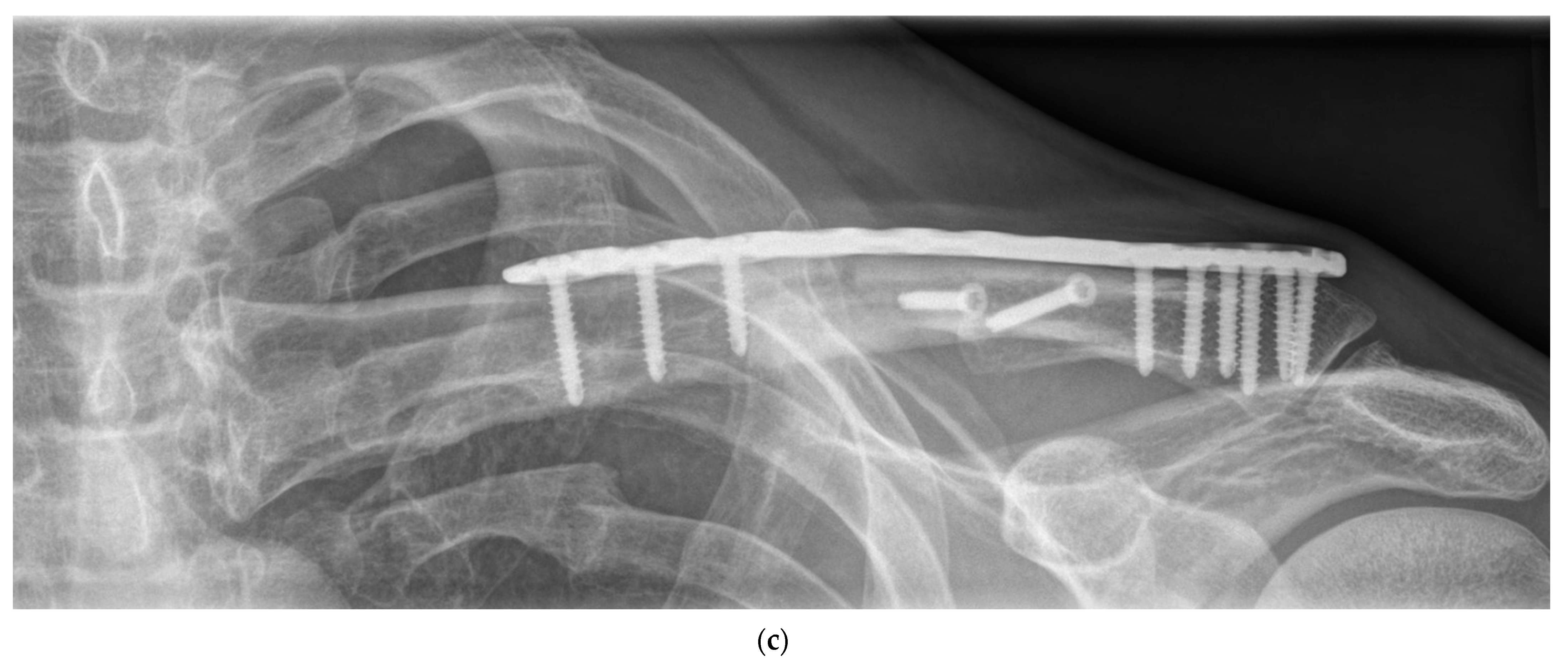Early Internal Fixation of Concomitant Clavicle Fractures in Severe Thoracic Trauma Prevents Posttraumatic Pneumonia
Abstract
1. Introduction
2. Patients and Methods
2.1. Follow-Up
2.2. Statistical Analysis
3. Results
4. Discussion
Study Limitations
5. Conclusions
Author Contributions
Funding
Institutional Review Board Statement
Informed Consent Statement
Data Availability Statement
Conflicts of Interest
References
- Huttunen, T.T.; Launonen, A.P.; Berg, H.E.; Lepola, V.; Fellander-Tsai, L.; Mattila, V.M. Trends in the incidence of clavicle fractures and surgical repair in Sweden: 2001–2012. J. Bone Jt. Surg. Am. 2016, 98, 1837–1842. [Google Scholar] [CrossRef]
- Yan, M.Z.; Yuen, W.S.; Yeung, S.C.; Wing-Yin, C.W.; Wong, S.C.; Si-Qi, W.W.; Tian, E.; Rashed, S.; Yung, C.S.Y.; Fang, C.X. Operative management of midshaft clavicle fractures demonstrates better long-term outcomes: A systematic review and meta-analysis of randomised controlled trials. PLoS ONE 2022, 17, e0267861. [Google Scholar] [CrossRef] [PubMed]
- Ronald, A.; Navarro, R.A.; Gelber, J.D.; Harrast, J.J.; Seiler, J.G.; Jackson, K.R.; Garcia, I.A. Frequency and complications after operative fixation of clavicular fractures. J. Shoulder Elb. Surg. 2016, 25, e125–e129. [Google Scholar] [CrossRef]
- Vécsei, V.; Arbes, S.; Aldrian, S.; Nau, T. Chest Injuries in Polytrauma. Eur. J. Trauma 2005, 31, 239–243. [Google Scholar] [CrossRef]
- Timm, A.; Maegele, M.; Lefering, R.; Wendt, K.; Wyen, H.; TraumaRegister DGU(®). Pre-hospital rescue times and actions in severe trauma. A comparison between two trauma systems: Germany and the Netherlands. Injury 2014, 45 (Suppl. S3), S43–S52. [Google Scholar] [CrossRef]
- Robinson, C.M. Fractures of the clavicle in the adult. Epidemiology and classification. J. Bone Jt. Surg. Br. 1998, 80, 476–484. [Google Scholar] [CrossRef]
- Kihlström, C.; Möller, M.; Lönn, K.; Wolf, O. Clavicle fractures: Epidemiology, classification and treatment of 2422 fractures in the Swedish Fracture Register; an observational study. BMC Musculoskelet. Disord. 2017, 18, 82. [Google Scholar] [CrossRef]
- Sweet, A.A.R.; Beks, R.B.; IJpma, F.F.A.; de Jong, M.B.; Beeres, F.J.P.; Leenen, L.P.H.; Houwert, R.M.; van Baal, M.C.P.M. Epidemiology of combined clavicle and rib fractures: A systematic review. Eur. J. Trauma Emerg. Surg. 2022, 48, 3513–3520. [Google Scholar] [CrossRef]
- Stahl, D.; Ellington, M.; Brennan, K.; Brennan, M. Association of Ipsilateral rib Fractures with Displacement of Midshaft clavicle fractures. J. Orthop. Trauma 2017, 31, 225–228. [Google Scholar] [CrossRef]
- Langenbach, A.; Krinner, S.; Hennig, F.F.; Ekkernkamp, A.; Schulz-Drost, S. Injuries of the posterior and lateral chest wall-importance of an additional clavicular fracture. Unfallchirurg 2018, 121, 615–623. [Google Scholar] [CrossRef]
- Majercik, S.; Pieracci, F.M. Chest Wall trauma. Thorac. Surg. Clin. 2017, 27, 113–121. [Google Scholar] [CrossRef] [PubMed]
- Wang, Z.; Jia, Y.; Li, M. The effectiveness of early surgical stabilization for multiple rib fractures: A multicenter randomized controlled trial. J. Cardiothorac. Surg. 2023, 18, 118. [Google Scholar] [CrossRef] [PubMed]
- Bakir, M.S.; Langenbach, A.; Pinther, M.; Lefering, R.; Krinner, S.; Grosso, M.; Ekkernkamp, A.; Schulz-Drost, S.; TraumaRegister, D.G.U. The significance of a concomitant clavicle fracture in flail chest patients: Incidence, concomitant injuries, and outcome of 12,348 polytraumata from the TraumaRegister DGU®. Eur. J. Trauma Emerg. Surg. 2022, 48, 3623–3634. [Google Scholar] [CrossRef] [PubMed]
- Sawyer, E.; Wullschleger, M.; Muller, N.; Muller, M. Surgical Rib Fixation of Multiple Rib Fractures and Flail Chest: A Systematic Review and Meta-analysis. J. Surg. Res. 2022, 276, 221–234. [Google Scholar] [CrossRef]
- von Rüden, C.; Bühren, V.; Perl, M. Polytrauma Management—Treatment of Severely Injured Patients in ER and OR. Z. Orthop. Unfall. 2017, 155, 603–622. [Google Scholar] [CrossRef] [PubMed]
- Allman, F.L. Fractures and ligamentous injuries of the clavicle and its articulation. J. Bone Jt. Surg. Am. 1967, 49, 774–784. [Google Scholar] [CrossRef]
- Dehghan, N.; Nauth, A.; Schemitsch, E.; Vicente, M.; Jenkinson, R.; Kreder, H.; McKee, M.; Canadian Orthopaedic Trauma Society and the Unstable Chest Wall RCT Study Investigators. Operative vs Nonoperative Treatment of Acute Unstable Chest Wall Injuries: A Randomized Clinical Trial. JAMA Surg. 2022, 157, 983–990. [Google Scholar] [CrossRef]
- Caspari, R.B.; Beach, W.R. Arthroscopic anterior shoulder capsulorrhaphy. Sports Med. Arthrosc. 1993, 1, 237–241. [Google Scholar] [CrossRef]
- Frima, H.; van Heijl, M.; Michelitsch, C.; van der Meijden, O.; Beeres, F.J.P.; Houwert, R.M.; Sommer, C. Clavicle fractures in adults; current concepts. Eur. J. Trauma Emerg. Surg. 2020, 46, 519–529. [Google Scholar] [CrossRef]
- Hudak, P.L.; Amadio, P.C.; Bombardier, C. Development of an upper extremity outcome measure: The DASH (disabilities of the arm, shoulder and hand) [corrected]. The Upper Extremity Collaborative Group (UECG). Am. J. Ind. Med. 1996, 29, 602–608. [Google Scholar] [CrossRef]
- Charles, E.R.; Kumar, V.; Blacknall, J.; Edwards, K.; Geoghegan, J.M.; Manning, P.A.; Wallace, W.A. A validation of the Nottingham Clavicle Score: A clavicle, acromioclavicular joint and sternoclavicular joint-specific patient-reported outcome measure. J. Shoulder Elb. Surg. 2017, 26, 1732–1739. [Google Scholar] [CrossRef]
- Fisher, J.S.; Kazam, J.J.; Fufa, D.; Bartolotta, R.J. Radiologic evaluation of fracture healing. Skelet. Radiol. 2019, 48, 349–361. [Google Scholar] [CrossRef]
- van Laarhoven, J.J.E.M.; Hietbrink, F.; Ferree, S.; Gunning, A.C.; Houwert, R.M.; Verleisdonk, E.M.M.; Leenen, L.P.H. Associated thoracic injury in patients with a clavicle fracture: A retrospective analysis of 1461 polytrauma patients. Eur. J. Trauma Emerg. Surg. 2019, 45, 59–63. [Google Scholar] [CrossRef] [PubMed]
- Bonnevie, T.; Gravier, F.E.; Ducrocq, A.; Debeaumont, D.; Viacroze, C.; Cuvelier, A.; Muir, J.F.; Tardif, C. Exercise testing in patients with diaphragm paresis. Respir. Physiol. Neurobiol. 2018, 248, 31–35. [Google Scholar] [CrossRef]
- Ramsook, A.H.; Molgat-Seon, Y.; Schaeffer, M.R.; Wilkie, S.S.; Camp, P.G.; Reid, W.D.; Romer, L.M.; Guenette, J.A. Effects of inspiratory muscle training on respiratory muscle electromyography and dyspnea during exercise in healthy men. J. Appl. Physiol. 2017, 122, 1267–1275. [Google Scholar] [CrossRef] [PubMed]
- Ware, L.B.; Matthay, M.A. The acute respiratory distress syndrome. N. Engl. J. Med. 2000, 342, 1334–1349. [Google Scholar] [CrossRef] [PubMed]
- Treggiari, M.M.; Hudson, L.D.; Martin, D.P.; Weiss, N.S.; Caldwell, E.; Rubenfeld, G. Effect of acute lung injury and acute respiratory distress syndrome on outcome in critically ill trauma patients. Crit. Care Med. 2004, 32, 327–331. [Google Scholar] [CrossRef]
- Geiger, E.V.; Lustenberger, T.; Wutzler, S.; Lefering, R.; Lehnert, M.; Walcher, F.; Laurer, H.L.; Marzi, I.; TraumaRegister DGU®. Predictors of pulmonary failure following severe trauma: A trauma registry-based analysis. Scand. J. Trauma Resusc. Emerg. Med. 2013, 21, 34. [Google Scholar] [CrossRef]
- Coppola, S.; Chiumello, D. Toracic trauma and acute respiratory distress syndrome: Mind the link! Minerva Anestesiol. 2017, 83, 83–1004. [Google Scholar] [CrossRef]
- Leinicke, J.A.; Elmore, L.; Freeman, B.D.; Colditz, G.A. Operative management of rib fractures in the setting of fail chest. Ann. Surg. 2013, 258, 914–921. [Google Scholar] [CrossRef]
- Schuurmans, J.; Goslings, J.C.; Schepers, T. Operative management versus non-operative management of rib fractures in fail chest injuries: A systematic review. Eur. J. Trauma Emerg. Surg. 2017, 43, 163–168. [Google Scholar] [CrossRef]
- Liao, C.A.; Kuo, L.W.; Huang, J.F.; Fu, C.Y.; Chen, S.A.; Tee, Y.S.; Hsieh, C.H.; Liao, C.H.; Cheng, C.T.; Young, T.H.; et al. Timely surgical fixation confers beneficial outcomes in patients’ concomitant flail chest with mild-to-moderate traumatic brain injury: A trauma quality improvement project analysis—A cohort study. Int. J. Surg. 2023, 109, 729–736. [Google Scholar] [CrossRef]
- Neer CS 2nd. Nonunion of the clavicle. J. Am. Med. Assoc. 1960, 172, 1006–1011. [CrossRef] [PubMed]
- Gossard, J.M. Closed treatment of displaced middle-third fractures of the clavicle gives poor results. J. Bone Jt. Surg. Br. 1998, 80, 558. [Google Scholar] [CrossRef]
- Ahrens, P.M.; Garlick, N.I.; Barber, J.; Tims, E.M.; The Clavicle Trial Collaborative Group. The Clavicle Trial A Multicenter Randomized Controlled Trial Comparing Operative with Nonoperative Treatment of Displaced Midshaft Clavicle Fractures. J. Bone Jt. Surg. Am. 2017, 99, 1345–1354. [Google Scholar] [CrossRef] [PubMed]
- Bayer, J.; Lefering, R.; Reinhardt, S.; Kühle, J.; Südkamp, N.P.; Hammer, T.; TraumaRegister, D.G.U. Severity-dependent diferences in early management of thoracic trauma in severely injured patients—Analysis based on the TraumaRegister DGU®. Scand. J. Trauma Resusc. Emerg. Med. 2017, 25, 10. [Google Scholar] [CrossRef]
- von Rüden, C.; Rehme-Röhrl, J.; Augat, P.; Friederichs, J.; Hackl, S.; Stuby, F.; Trapp, O. Evidence on treatment of clavicle fractures. Injury 2023, 110818, Online ahead of print. [Google Scholar] [CrossRef]
- Eberbach, H.; Lefering, R.; Hager, S.; Schumm, K.; Bode, L.; Jaeger, M.; Maier, D.; Kalbhenn, J.; Hammer, T.; Schmal, H.; et al. Influence of surgical stabilization of clavicle fractures in multiply-injured patients with thoracic trauma. Sci. Rep. 2021, 11, 23263. [Google Scholar] [CrossRef] [PubMed]
- Hill, A.B.; Fleiszer, D.M.; Brown, R.A. Chest trauma in a Canadian urban setting—Implications for trauma research in Canada. J. Trauma 1991, 31, 971–973. [Google Scholar] [CrossRef]
- Grubmüller, M.; Kerschbaum, M.; Diepold, E.; Angerpointner, K.; Nerlich, M.; Ernstberger, A. Severe thoracic trauma—Still an independent predictor for death in multiple injured patients? Scand. J. Trauma Resusc. Emerg. Med. 2018, 26, 6. [Google Scholar] [CrossRef]
- Biberthaler, P.; Schubert, E.C.; Kirchhoff, C.; Kanz, K.G. Current management of midshaft clavicle fractures. MMW Fortschr. Med. 2015, 157, 50–53. [Google Scholar] [CrossRef] [PubMed]
- Nowak, J.; Holgersson, M.; Larsson, S. Can we predict long-term sequelae after fractures of the clavicle based on initial findings? A prospective study with nine to ten years of follow-up. J. Shoulder Elb. Surg. 2004, 13, 479–486. [Google Scholar] [CrossRef] [PubMed]


| Operative (Group OP) | Non-Operative (Group NO) | p-Value | |
|---|---|---|---|
| Patients [number] | 116 | 65 | |
| Gender [male/female] | 97/19 | 42/23 | 0.004 |
| Age [years] | 48 ± 14 | 53 ± 20 | 0.06 |
| Injured side [right/left] | 47/69 | 24/41 | 0.63 |
| Allman classification [midshaft/lateral/medial] | 88/25/3 | 35/29/1 | <0.01 |
| ISS (mean ± SD) [points] | 17.8 ± 9.8 | 19.9 ± 14.4 | 0.93 |
| Polytrauma [yes/no] | 70/46 | 34/31 | 0.29 |
| Operative (Group OP) | Non-Operative (Group NO) | p-Value | |
|---|---|---|---|
| Time on ICU [days] | 9.1 ± 8.9 | 8.1 ± 7.7 | 0.25 |
| Ventilation time [days] | 7.5 ± 10 | 13.6 ± 9 | 0.04 |
| Time in hospital [days] | 21.5 ± 27.2 | 16 ± 29.3 | 0.04 |
| Pneumonia [yes/no] | 2/114 | 9/56 | <0.001 |
| Operative (Group OP) | Non-Operative (Group NO) | p-Value | |
|---|---|---|---|
| Follow-up period [years] | 7 (1–15) | 8 (1–16) | |
| DASH [points] | 10 ± 17 | 13.7 ± 18.4 | 0.39 |
| Modified NCS [points] | 17.3 ± 7.5 | 19.4 ± 10.3 | 0.63 |
| VAS [points] | 1.9 ± 2.5 | 2.4 ± 2.3 | 0.29 |
Disclaimer/Publisher’s Note: The statements, opinions and data contained in all publications are solely those of the individual author(s) and contributor(s) and not of MDPI and/or the editor(s). MDPI and/or the editor(s) disclaim responsibility for any injury to people or property resulting from any ideas, methods, instructions or products referred to in the content. |
© 2023 by the authors. Licensee MDPI, Basel, Switzerland. This article is an open access article distributed under the terms and conditions of the Creative Commons Attribution (CC BY) license (https://creativecommons.org/licenses/by/4.0/).
Share and Cite
Rehme-Röhrl, J.; Sicklinger, K.; Brand, A.; Fürmetz, J.; Neuerburg, C.; Stuby, F.; von Rüden, C. Early Internal Fixation of Concomitant Clavicle Fractures in Severe Thoracic Trauma Prevents Posttraumatic Pneumonia. J. Clin. Med. 2023, 12, 4878. https://doi.org/10.3390/jcm12154878
Rehme-Röhrl J, Sicklinger K, Brand A, Fürmetz J, Neuerburg C, Stuby F, von Rüden C. Early Internal Fixation of Concomitant Clavicle Fractures in Severe Thoracic Trauma Prevents Posttraumatic Pneumonia. Journal of Clinical Medicine. 2023; 12(15):4878. https://doi.org/10.3390/jcm12154878
Chicago/Turabian StyleRehme-Röhrl, Julia, Korbinian Sicklinger, Andreas Brand, Julian Fürmetz, Carl Neuerburg, Fabian Stuby, and Christian von Rüden. 2023. "Early Internal Fixation of Concomitant Clavicle Fractures in Severe Thoracic Trauma Prevents Posttraumatic Pneumonia" Journal of Clinical Medicine 12, no. 15: 4878. https://doi.org/10.3390/jcm12154878
APA StyleRehme-Röhrl, J., Sicklinger, K., Brand, A., Fürmetz, J., Neuerburg, C., Stuby, F., & von Rüden, C. (2023). Early Internal Fixation of Concomitant Clavicle Fractures in Severe Thoracic Trauma Prevents Posttraumatic Pneumonia. Journal of Clinical Medicine, 12(15), 4878. https://doi.org/10.3390/jcm12154878







